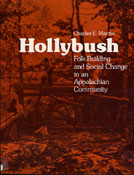Hollybush
Folk Building and Social Change in an Appalachian Community

- Author(s): Martin, Charles E.
- Series:
- Imprint: Univ Tennessee Press
- Publication Date: 1993-08-30
- Status: Active
- Available in Paper: Price $18.00 | Buy Now
Winner of the Abbott Lowell Cummings Prize and the Gustav O. Arlt Award in Humanities
The Appalachian community of Hollybush, first settled in 1881, grew to a population of some 150 people on thirty farm sites. Charles Martin shows that its abandonment in 1960 resulted from technological change, which brought social upheaval manifested in the region’s now-vanished architecture. Martin’s analysis makes innovative use of the techniques of oral history and material culture. The essential data incorporated within the building survey document the physical displacement that occurred in the community as it attempted to switch from an agrarian to an industrial system. The author assesses the resulting social conflict, showing how coal provided the catalyst for change to which residents so profoundly reacted. In the experience of Hollybush the author discovers a paradigm of the social changes wrought by industrialism elsewhere in America.
“With its important methodological contributions, its fruitful historic conclusions, and above all, its well-illustrated and carefully documented corpus of particular data from a vanished kind of American community, Hollybush deserves attention and scrutiny by folklorists, oral historians, Appalachian scholars, and material culturists everywhere.”
— Thomas A. Adler, Winterthur Portfolio
“Charles Martin has expertly combined oral history with folk architectural studies to reconstruct an amazingly full picture of the demographics, built landscapes, and daily lives of the people of Hollybush, Kentucky.”
— John Wolford, Folklore Forum
